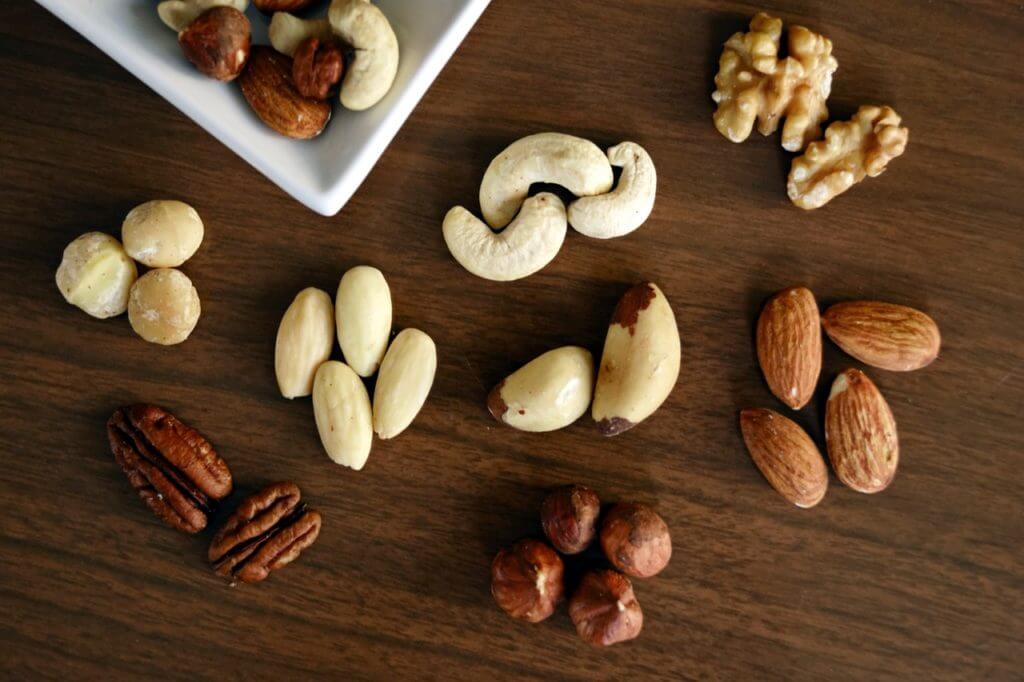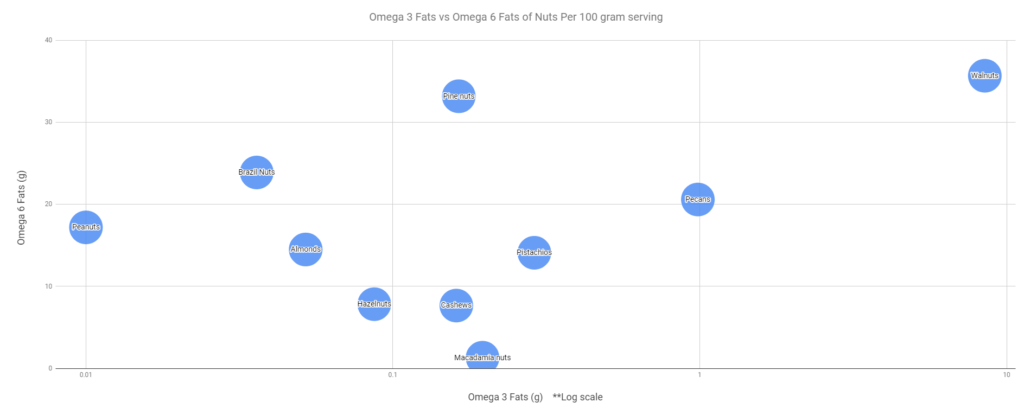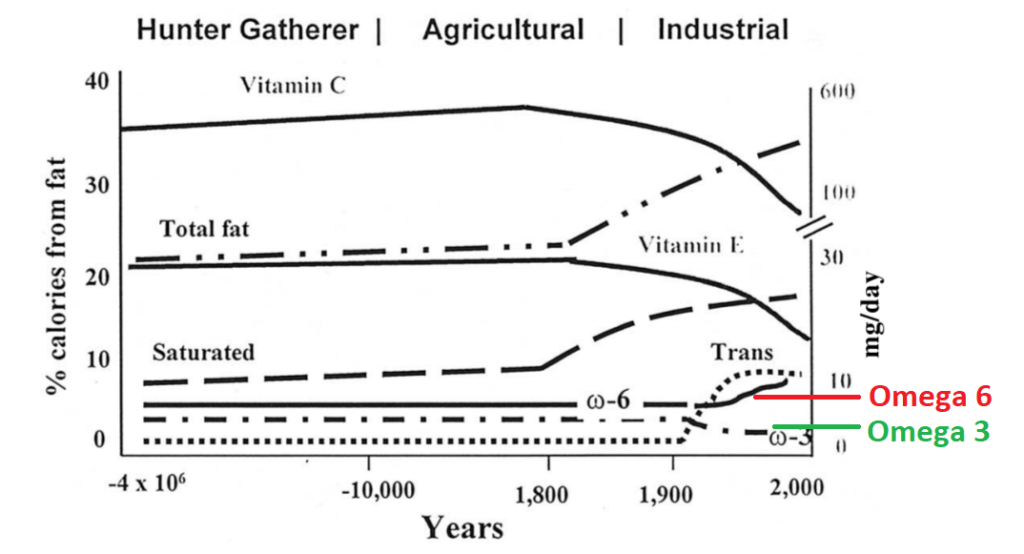 Nuts are one of the best vegan sources of fats, and have some protein too. But, there’s that pesky issue of having a ton of omega 6 fats, and not many omega 3 fats.
Nuts are one of the best vegan sources of fats, and have some protein too. But, there’s that pesky issue of having a ton of omega 6 fats, and not many omega 3 fats.
If you’re reading this, I suspect you already know why keeping a high ratio of Omega 3:6 fatty acids is a good idea, so I’ll get right into the data instead.
I collected nutritional data for all common nuts that I could think of.
If I missed any, just let me know and I’ll add it.
Omega 6:3 Fat Ratio of Nuts Table
Here’s a table of the fats in 100 grams of each nut.
Pay special attention to the columns on the far right. In theory, we want this ratio to be as low as possible, ideally close to 1. I’ve summarized the research on this in later sections down the page if you need a refresher.
| Omega 3 Fats (g) | Omega 6 Fats (g) | Omega 6:3 Ratio | |
|---|---|---|---|
| Walnuts | 8.49 | 35.7 | 4.20 |
| Macadamia nuts | 0.196 | 1.3 | 6.63 |
| Pecans | 0.986 | 20.6 | 20.89 |
| Cashews | 0.161 | 7.66 | 47.58 |
| Pistachios | 0.289 | 14.1 | 48.79 |
| Hazelnuts | 0.087 | 7.83 | 90.00 |
| Pine nuts | 0.164 | 33.2 | 202.44 |
| Almonds | 0.052 | 14.5 | 278.85 |
| Brazil Nuts | 0.036 | 23.9 | 663.89 |
| Peanuts | 0.01 | 17.2 | 1720.00 |
Here’s a few things that you might want to takeaway from this:
- Walnuts have the best omega 6:3 fat ratio, which is basically right at the limit of what is considered healthy in isolation (see sections below for explanation).
- Macadamia nuts have a good omega 6:3 ratio, but also a low amount of both fats in the first place. Most of its fats are monounsaturated fats (Omega 3s and 6s are polyunsaturated fats).
- Almonds, peanuts, and Brazil nuts have essentially zero omega 3 fats and should really be eaten in limited quantities. This is one reason why nuts like almonds can cause inflammation.
A Visual Look at the Omega 3 to 6 Ratio of Nuts
The chart below is the exact same data above, just in a bubble chart. You can click it to open it bigger.
The ideal nut would be far to the right, and close to the bottom. Note that the X-axis uses a log scale otherwise walnuts are way to the right and everything else is just bunched up.
In case you’re having trouble seeing the chart, there are a few important takeaways:
- The top 3 nuts in terms of having a good ratio are easy to identify along that diagonal line: walnuts, macadamia nuts, and pecans.
- Macadamia nuts have nearly no omega 6 fats, but still a decent amount of omega 3 fats.
- Walnuts have the most omega 3 fats per serving of any nut by far, but also the highest amount of omega 6 fats.
- Peanuts (on the left side of the chart), while not technically nuts, have a significant amount of omega 6 fats, with next to no omega 3 fats.
Which Nuts Are Highest in Omega 3 Fats?
It’s important to keep in mind that not only the ratio of omega 3 and 6 fats matter, but also the quantity of the “desired” omega 3 fats. For example, macadamia nuts have a good ratio of omega fats, but a relatively low quantity of omega 3s.
Overall, walnuts are by far the nut highest in omega 3 fats. Pecans and pistachios also have a relatively high quantity of omega 3s as well.
What’s the Ideal Ratio of Omega 3 to 6 Fats?
Research suggests that humans evolved on a diet with a omega 6:3 ratio of approximately 1 (source).
More recently, particularly in Western diets, the ratio is more like 15:1 to 17:1, which causes inflammation and all sorts of health risks.
You can see in the image that the lines for omega 6 and omega 3 calories were straight until the 20th century, where they started to diverge.
While nuts certainly aren’t the driving issue of this (processed foods and cooking oils are the main ones), nuts can make our ratio worse if we already have a poor ratio.
There’s no exact optimum ratio in terms of convenience and health benefits.
But current research generally supports the idea that an omega 6:omega 3 ratio of 4:1 or below is likely close to optimal.
It’s tough to say anything beyond that at this time.
How To Get More Omega 3s to Balance Out Nuts
Hopefully that data helps you reach your nutritional targets, whatever they may be.
If you eat a lot of nuts, you’ll want to try and balance them out by getting omega 3 fats from other sources.
Depending on your diet, this may come from fish, but there are also good plant sources of omega 3s as well. You might also be interested in this list of vegan recipes high in omega 3s.
The plant-based sources that I personally focus on eating more are mainly seeds. In particularly, I try to eat a lot of:
- Flax seeds
- Chia seeds
- Hemp seeds
If you happen to be vegan, where a plant-based source is your only option, an algae-based vegan omega 3 supplement is a good option to help keep your ratio somewhat reasonable.
Finally, you might also be interested in a similar post that I’ve made with the omega 3 to omega 6 fat ratios of common seeds.



This is awesome. Do you have anything like this for seed such as flax, chia, hemp, sesame, etc?
I created another page for seeds: https://vegfaqs.com/omega-3-to-6-fat-ratio-of-seeds/